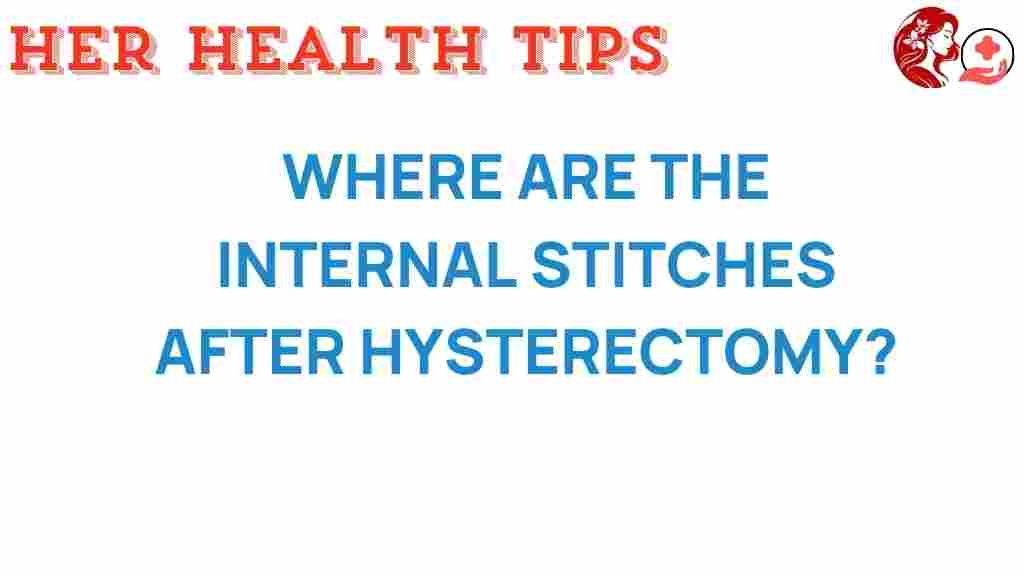The Hidden Journey: Where Are the Internal Stitches After Hysterectomy?
Undergoing a hysterectomy is a significant surgical procedure for many women, often performed to address various medical conditions such as uterine fibroids, endometriosis, or abnormal bleeding. While much attention is given to the external aspects of recovery, the internal stitches play a crucial role in the healing process. Understanding these stitches, their purpose, and how they fit into the anatomy of a woman’s body can help ease concerns during recovery. In this article, we will explore the journey of internal stitches after a hysterectomy, focusing on recovery, women’s health, and postoperative care.
Understanding Hysterectomy
A hysterectomy involves the surgical removal of the uterus and sometimes surrounding structures. It can be performed through different approaches, including:
- Abdominal hysterectomy: Involves a larger incision in the abdomen.
- Vaginal hysterectomy: The uterus is removed through the vagina, resulting in no visible scar.
- Laparoscopic hysterectomy: Minimally invasive procedure using small incisions and a camera.
Each method has its advantages and potential complications, but all involve some form of internal stitching to secure the remaining tissues and promote healing.
The Anatomy of Internal Stitches
After a hysterectomy, internal stitches are placed where the uterus was attached to the surrounding tissues, including:
- Uterosacral ligaments: These ligaments help support the uterus and are often stitched back together.
- Broad ligaments: Stitches here may help maintain the integrity of the pelvic structure.
- Vagina: If the cervix is removed, the top of the vagina is stitched to close the surgical site.
These stitches are typically made from materials that are either absorbable or non-absorbable. Absorbable stitches dissolve over time, while non-absorbable stitches may require removal. The type used will depend on the surgeon’s preference and the specifics of the surgical procedure.
Recovery After Hysterectomy
The recovery period after a hysterectomy can vary significantly among women. Generally, the recovery can be divided into several phases:
- Immediate Postoperative Phase: This phase lasts from the time of surgery to a few days after. Women may experience pain, swelling, and fatigue during this time.
- Early Recovery Phase: This phase lasts about 2 to 6 weeks. Women may gradually resume light activities but should avoid heavy lifting and strenuous exercise.
- Long-term Recovery Phase: This phase can continue for several months, during which women should pay attention to their bodies and adjust their activities as needed.
Postoperative Care for Internal Stitches
Proper postoperative care is essential for healing and minimizing complications. Here are some tips for caring for internal stitches after a hysterectomy:
- Follow Your Surgeon’s Instructions: Adhere to all postoperative care instructions provided by your healthcare provider.
- Manage Pain: Use prescribed pain medications to manage discomfort and promote mobility.
- Rest: Prioritize rest to allow the body to heal effectively.
- Monitor for Complications: Be vigilant for signs of infection, excessive bleeding, or unusual pain.
- Stay Hydrated and Eat Well: A balanced diet and adequate hydration support the healing process.
What to Expect During Recovery
During recovery, women may experience various symptoms related to the healing process. Some common occurrences include:
- Discomfort or Pain: It is normal to feel some pain around the incision sites.
- Vaginal Discharge: Light discharge can occur as the body heals.
- Emotional Changes: Hormonal changes may affect mood and emotional well-being.
Understanding these symptoms can help women know what is typical and when to seek medical advice.
Complications Related to Internal Stitches
While most recoveries are uncomplicated, it is essential to be aware of potential complications related to internal stitches:
- Infection: Signs include fever, increased pain, or discharge from the incision site.
- Dehiscence: This refers to the reopening of the surgical wound, which may require additional treatment.
- Adhesions: Scar tissue may form and cause internal organs to stick together, leading to pain or bowel obstruction.
If any of these complications arise, it is crucial to consult with a healthcare provider promptly.
Step-by-Step Process of Healing
The healing process after a hysterectomy can be thought of as a journey, with several key milestones:
- Day of Surgery: Women will be monitored in recovery for pain management.
- First Week: Focus on rest, managing pain, and starting light movement.
- Two Weeks: Gradual increase in activity, with a follow-up appointment to check healing.
- One Month: Many women can return to work or normal activities, but heavy lifting should still be avoided.
- Three Months: Most internal stitches should be fully healed, and women can usually resume all normal activities.
Each woman’s journey is unique, and healing times may vary based on individual circumstances.
Troubleshooting Tips for Common Concerns
As women navigate their recovery, they may encounter various concerns. Here are some troubleshooting tips:
- Pain Management: If pain is not relieved by medications, consult your doctor for alternative options.
- Excessive Bleeding: Contact your healthcare provider if you experience heavy bleeding or clots.
- Infection Symptoms: If you notice persistent fever or unusual discharge, seek medical attention.
Being proactive and informed can significantly aid in a smoother recovery process.
Conclusion
The journey of recovery after a hysterectomy involves understanding the role of internal stitches in healing. By staying informed about the surgical procedure, postoperative care, and potential complications, women can better navigate their recovery journey. Remember that each woman’s healing process is unique, and maintaining open communication with healthcare providers is essential for optimal recovery.
For more information on women’s health and recovery after a hysterectomy, consider visiting this resource. If you have specific concerns about your recovery, don’t hesitate to consult your healthcare provider.
This article is in the category Reproductive and created by HerHealthTips Team
